J wave syndromes
- PMID: 20153265
- PMCID: PMC2843811
- DOI: 10.1016/j.hrthm.2009.12.006
J wave syndromes
Abstract
The J wave, also referred to as an Osborn wave, is a deflection immediately following the QRS complex of the surface ECG. When partially buried in the R wave, the J wave appears as J-point elevation or ST-segment elevation. Several lines of evidence have suggested that arrhythmias associated with an early repolarization pattern in the inferior or mid to lateral precordial leads, Brugada syndrome, or arrhythmias associated with hypothermia and the acute phase of ST-segment elevation myocardial infarction are mechanistically linked to abnormalities in the manifestation of the transient outward current (I(to))-mediated J wave. Although Brugada syndrome and early repolarization syndrome differ with respect to the magnitude and lead location of abnormal J-wave manifestation, they can be considered to represent a continuous spectrum of phenotypic expression that we propose be termed J-wave syndromes. This review summarizes our current state of knowledge concerning J-wave syndromes, bridging basic and clinical aspects. We propose to divide early repolarization syndrome into three subtypes: type 1, which displays an early repolarization pattern predominantly in the lateral precordial leads, is prevalent among healthy male athletes and is rarely seen in ventricular fibrillation survivors; type 2, which displays an early repolarization pattern predominantly in the inferior or inferolateral leads, is associated with a higher level of risk; and type 3, which displays an early repolarization pattern globally in the inferior, lateral, and right precordial leads, is associated with the highest level of risk for development of malignant arrhythmias and is often associated with ventricular fibrillation storms.
Copyright 2010 Heart Rhythm Society. Published by Elsevier Inc. All rights reserved.
Conflict of interest statement
Figures
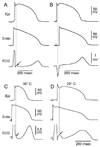
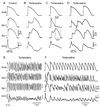
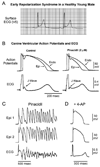
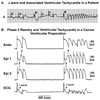

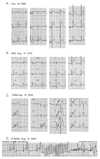

Similar articles
-
J-wave syndromes. from cell to bedside.J Electrocardiol. 2011 Nov-Dec;44(6):656-61. doi: 10.1016/j.jelectrocard.2011.07.026. Epub 2011 Sep 9. J Electrocardiol. 2011. PMID: 21908004 Free PMC article.
-
[Doubts of the cardiologist regarding an electrocardiogram presenting QRS V1-V2 complexes with positive terminal wave and ST segment elevation. Consensus Conference promoted by the Italian Cardiology Society].G Ital Cardiol (Rome). 2010 Nov;11(11 Suppl 2):3S-22S. G Ital Cardiol (Rome). 2010. PMID: 21361048 Italian.
-
J wave syndromes: molecular and cellular mechanisms.J Electrocardiol. 2013 Nov-Dec;46(6):510-8. doi: 10.1016/j.jelectrocard.2013.08.006. Epub 2013 Sep 6. J Electrocardiol. 2013. PMID: 24011992 Free PMC article. Review.
-
Early Repolarization Pattern Is Associated with Increased Risk of Early Ventricular Arrhythmias during Acute ST Segment Elevation Myocardial Infarction.Ann Noninvasive Electrocardiol. 2015 Sep;20(5):474-80. doi: 10.1111/anec.12249. Epub 2014 Dec 22. Ann Noninvasive Electrocardiol. 2015. PMID: 25530270 Free PMC article.
-
Early repolarization pattern: innocent finding or marker of risk?J Electrocardiol. 2013 Jul-Aug;46(4):297-301. doi: 10.1016/j.jelectrocard.2013.02.008. Epub 2013 Mar 26. J Electrocardiol. 2013. PMID: 23540936 Review.
Cited by
-
Properties and molecular determinants of the natural flavone acacetin for blocking hKv4.3 channels.PLoS One. 2013;8(3):e57864. doi: 10.1371/journal.pone.0057864. Epub 2013 Mar 20. PLoS One. 2013. PMID: 23526953 Free PMC article.
-
A nonsynonymous polymorphism in semaphorin 3A as a risk factor for human unexplained cardiac arrest with documented ventricular fibrillation.PLoS Genet. 2013 Apr;9(4):e1003364. doi: 10.1371/journal.pgen.1003364. Epub 2013 Apr 11. PLoS Genet. 2013. PMID: 23593010 Free PMC article.
-
Prolongation of The Activation Time in Ischemic Myocardium is Associated with J-wave Generation in ECG and Ventricular Fibrillation.Sci Rep. 2019 Aug 21;9(1):12202. doi: 10.1038/s41598-019-48710-3. Sci Rep. 2019. PMID: 31434969 Free PMC article.
-
Prominent J Waves and Ventricular Fibrillation Caused by Myocarditis and Pericarditis After BNT162b2 mRNA COVID-19 Vaccination.Can J Cardiol. 2022 Jun;38(6):844-847. doi: 10.1016/j.cjca.2022.02.005. Epub 2022 Feb 10. Can J Cardiol. 2022. PMID: 35151782 Free PMC article. No abstract available.
-
Brugada Syndrome: Evolving Insights and Emerging Treatment Strategies.J Innov Card Rhythm Manag. 2017 Feb 15;8(2):2613-2622. doi: 10.19102/icrm.2017.080205. eCollection 2017 Feb. J Innov Card Rhythm Manag. 2017. PMID: 32477767 Free PMC article. Review.
References
-
- Osborn JJ. Experimental hypothermia: respiratory and blood pH changes in relation to cardiac function. Am J Physiol. 1953;175:389–398. - PubMed
-
- Yan GX, Antzelevitch C. Cellular basis for the electrocardiographic J wave. Circulation. 1996;93:372–379. - PubMed
-
- Gussak I, Antzelevitch C. Early repolarization syndrome: clinical characteristics and possible cellular and ionic mechanisms. J Electrocardiol. 2000;33:299–309. - PubMed
-
- Yan GX, Yao QH, Wang DQ, Cui CC. Electrocardiographic J wave and J wave syndromes. Chin J Cardiac Arrhyth. 2004;8:360–365.
-
- Shu J, Zhu T, Yang L, Cui C, Yan GX. ST-segment elevation in the early repolarization syndrome, idiopathic ventricular fibrillation, and the Brugada syndrome: cellular and clinical linkage. J Electrocardiol. 2005;38:26–32. - PubMed
Publication types
MeSH terms
Grants and funding
LinkOut - more resources
Full Text Sources
Medical
Molecular Biology Databases

